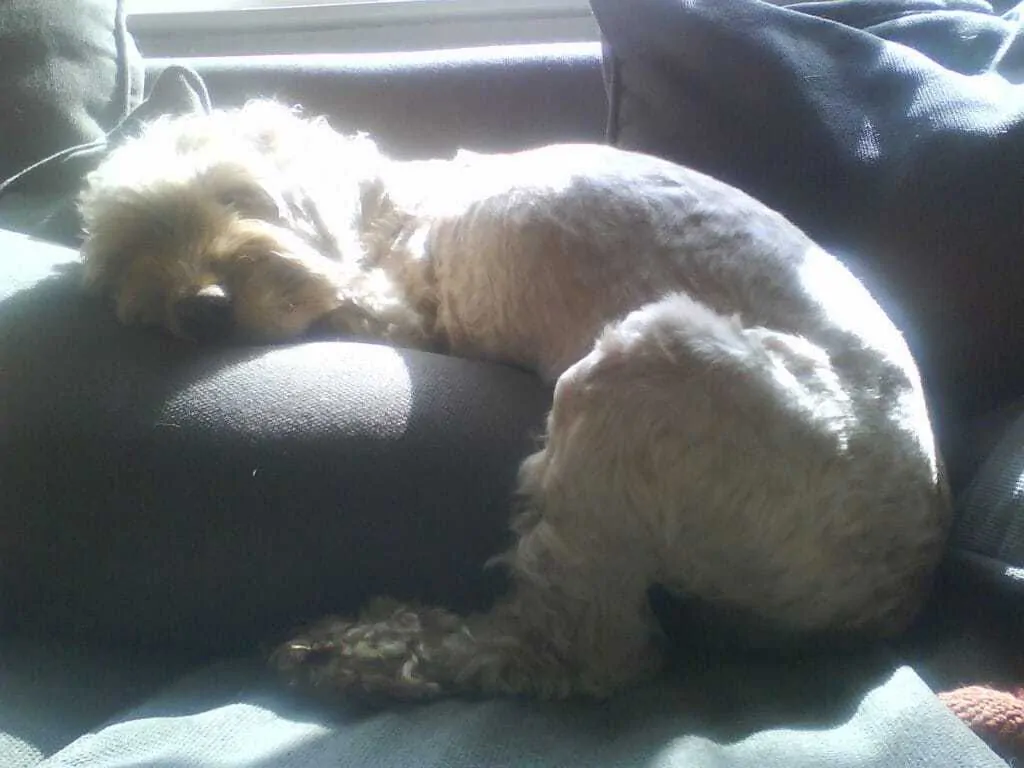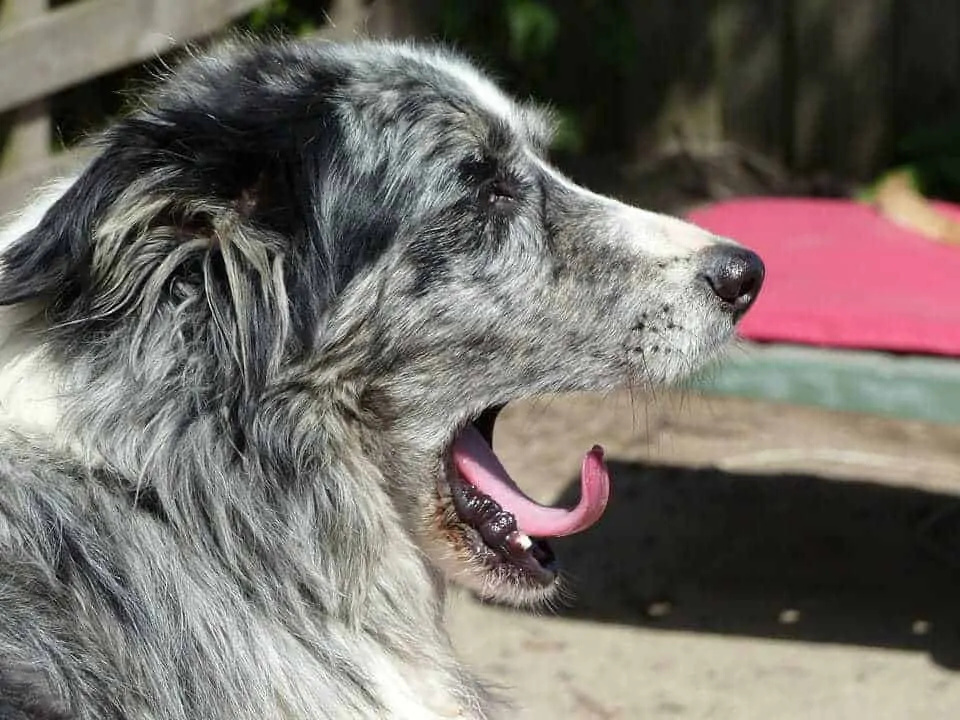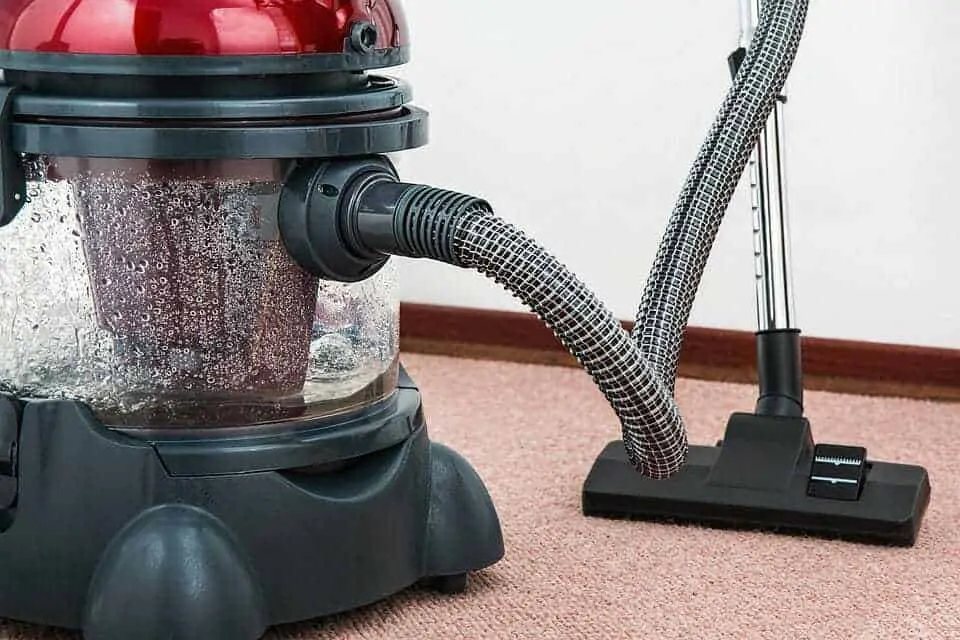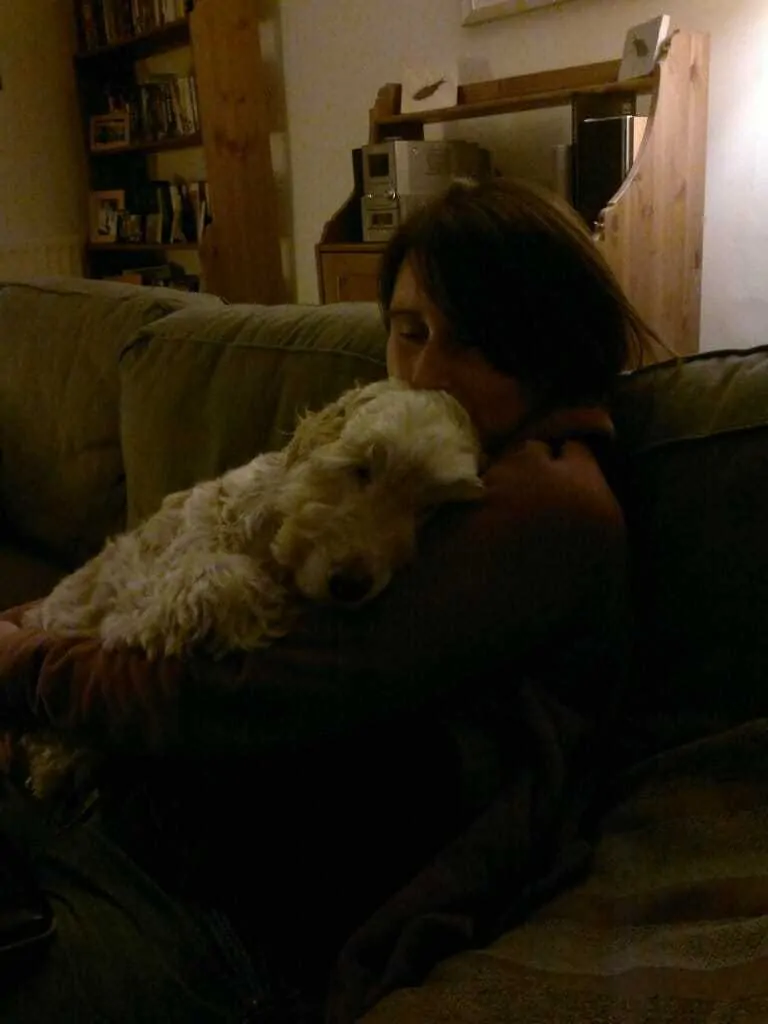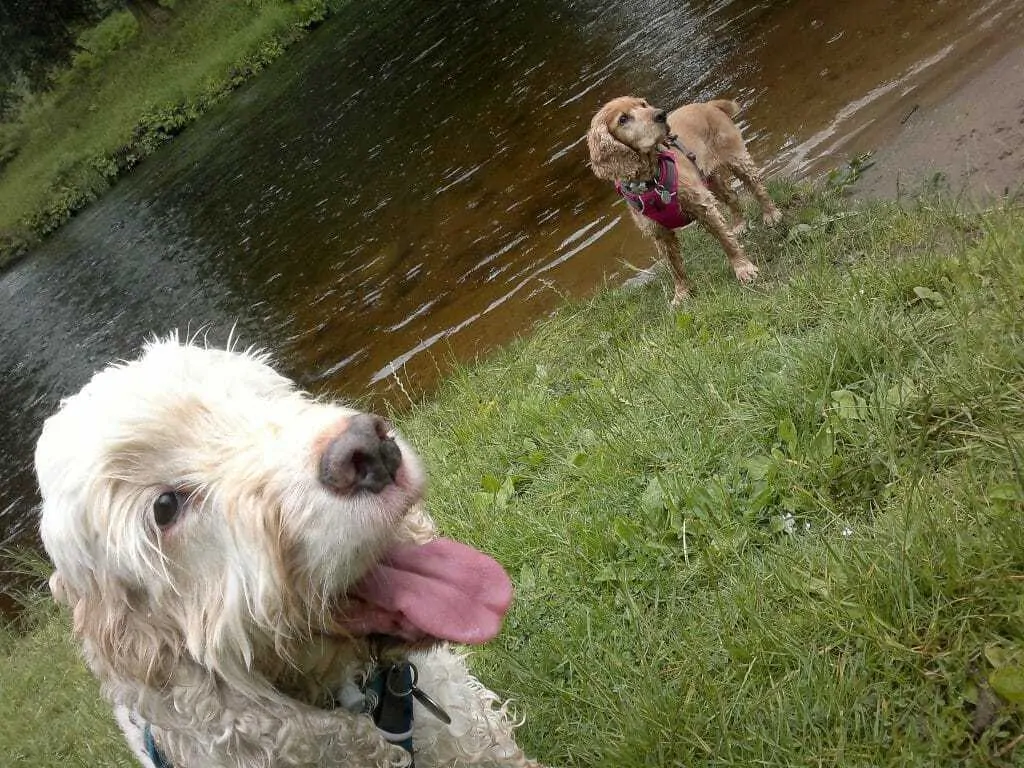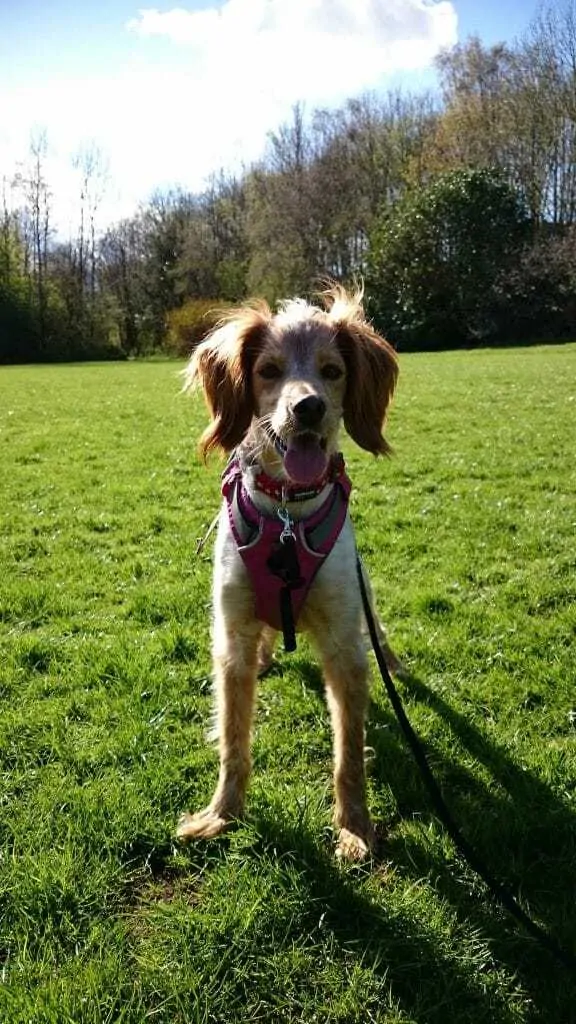Want to know how to calm an anxious dog? Living with an anxious and fearful dog can be a challenge. You often have to make compromises on a daily basis and working towards removing a fearful reaction, whatever it may be towards, can be a long process. There are no quick fixes.
At the same time, it can be a hugely rewarding experience. Developing a close bond with your dog through the support and help that you give them is priceless. Watching your dogs become more relaxed and happy is such a true privilege.
Of the three dogs I have had, two of them have has severe anxiety issues. Sam, my rescue Cocker Spaniel, was very poorly socialised as a puppy and, along with various other factors, this made him an anxious and fearful boy. Strange dogs scared him, new situations stressed him out, a change in his routine was a source of anxiety. We had to employ a lot of management techniques as well as a lot of intensive training to get him to a point where he felt safe and relaxed. He also had separation anxiety. He really set me off on my dog training and behaviour journey.
A lot of compromises had to be made in terms of lifestyle to ensure that we helped him to have the most relaxing life and overcome the dog’s anxiety issues. It was totally worth it! He was the best boy and gave us a lot of love and joy for over 13 years.
Little Sam was a special lad. He was very fearful and we had to work a lot on issues related to anxiety in dogs. With lots of positive training and management and work with a veterinary behaviorist, he led a very happy life and overcame much of the dog’s anxiety issues.
Annie, my most recent dog, was rescued from a Perrera in Spain. She had been abandoned by her hunter owner and had obviously had bad experiences with people in the past. She was extremely nervous around strangers, especially men. With a lot of love, patience and behaviour work with a veterinary behaviorist, she is a different dog today but she continues to be nervous of new men and doesn’t like to be in crowded spaces.
It is something I will continue to work on. Seeing her become a much more relaxed dog who now enjoys her walks with a spark in her eyes and her tail held high is hugely satisfying.
Contents
1. The most important tip of all: Don’t use punishment with an anxious dog!
We never advocate the use of punishment when training dogs but, when working with fearful dogs, using punishment can be seriously damaging and will almost always make your dogs worse rather than better. Why would you want to use something aversive when your dogs are already afraid? It will also likely only serve to hinder or damage the bond of trust you are working to build with your dogs. It will do little to alleviate anxiety in dogs.
2. Recognise the signs of anxiety in dogs
Okay, so if your dogs start to tremble and whine or, worse, they may not be able to control their bowels or bladder when exposed to something, it is pretty obvious they are afraid. Some signs are much more subtle than this though, and a big part of recognising when your dogs are afraid is by paying close attention to their body language.
Below are some other things to look out for to help you understand if your dogs are stressed:
- Tucked tail, ears flat to the head, tightly closed mouth, the whites of the eye may be showing (this is often referred to as “whale eye”).
- Looking away/averting eye contact
- A hunched, cowering, crouched body position
- Hiding in a “safe space” (under the bed, under the kitchen table, etc)
- Lip licking and yawning can be a sign of being uncomfortable.
- Dogs will often sniff excessively when stressed out
- When your dogs are on the leash, if they feel uncomfortable they may be more aggressively reactive to people or dogs that approach. Whilst many people can assume that this is just your dogs being grumpy, this may be their way of coping because they are fearful of the situation. In their mind, they think “If I bark and growl, that makes the thing I am scared of go away”.
- Pacing, panting and drooling. Your dogs may be panting despite there not being extreme heat or overexertion
Yawning can be an appeasement signal and a sign that a dog is feeling anxious
3. What can make dogs anxious?
Every dog will have different triggers. Sometimes it may be something you would expect. For example, you may have taken on a rescue dog that you know has been abused by their previous owner. You would then expect them to be nervous around people. Other things may be less expected.
Some common sources of anxiety can include:
- A history of abuse
- Not getting proper socialisation during the crucial initial 8 weeks of life, or having a scary experience during the “fear” phase of puppyhood, which tends to be around 8 – 12 weeks of age.
- An extreme change of circumstance. Things like being moved from a family home to a stressful rescue kennel environment, or losing an owner that they have lived with for a long time.
- Being attacked by another dog
- An accident. For example, perhaps they have been hit by a bike. This may then mean the develop a very fearful reaction whenever a bike is present.
- Prolonged exposure to something mildly stressful can result in developing a severe fear. If a child is continually pestering and teasing dogs, the dogs can start to develop a general fear of children and may start to react defensively as a result.
- Noisy things. Hoovers, hair dryers, fireworks and anything else similar can be frightening, especially for sound sensitive dogs
- Separation anxiety – your anxious dog may not want to be home alone
Even everyday household items, like a vacuum cleaner, can be a source of anxiety for your pet. Help your dogs keep calm and overcome anxiety by managing what triggers they see at home.
4. Help dogs keep calm and feel safe: management can be a crucial tool
It may sound counter-intuitive to say that if your dogs are frightened of other dogs you shouldn’t have any contact with them. How can you help your dogs to get over their fear if you never expose them to what triggers it, right?
We don’t mean that you should ensure your dog avoids other dogs for the rest of their life. Not only would that be pretty difficult to manage, but it would mean some major, often impractical changes in lifestyle that are not necessarily good for you or your dog. We just mean that, until you have the tools to start working on modifying your dog’s fear reaction, and whilst you are working on it, you want to control how and when your dog is exposed to these triggers. Perhaps walk a quieter route, or at a quieter time of the day.
If you do meet another dog on your walk, be proactive to calm your anxious dog. Perhaps cross over to the other side of the street, let the other person know your dog needs space or turn and walk in the opposite direction.
If you keep just taking them out, exposing them to lots of dogs and allowing them to react as they always have everytime they pass these dogs, not only is it more likely that a full-blown dog fight will occur, but it also means that you could be increasing your dog’s anxiety and you are not helping them to feel safe.
If they are frightened of strangers and you know you are having friends round for dinner, you should consider having your dogs in a separate room or, if they are settled in a crate, this could become their safe space for the evening.
Only by helping them to feel safe, will you be able to keep their anxiety levels low enough to allow them to feel relaxed enough to be receptive to any behaviour modification training you will do.
5. Think about the equipment you might need to help you with your management
Whilst you are working on a training programme and you are managing your dog’s environment to help minimise their stress levels, there may be certain tools that might help you.
Some dogs respond well to Thundershirts or other anxiety wraps. These work by creating a firm and constant body pressure and this can often make your dog feel calmer. If you want to know more about the principles behind this premise we recommend reading about the Tellington T Touch principles. Thundershirts are expensive but if your dog has severe anxiety and they respond to this kind of product it can be very worthwhile.
Some people try fashioning a homemade version to try to work out if the real deal would be worth investing in. You could try wrapping bandages around the core part of the dog’s body, some pressure needs to be applied but not so much that it will affect circulation.
We would always recommend putting the Thundershirt on at random times and not just when you are exposing them to the trigger that causes a fearful reaction. Not doing so could inadvertently teach your dog to associate the Thundershirt with the thing they are scared of.
Providing a safe space for your dog can be an important management tool. Your dog may like a cosy den that they can retreat to if there is something in their home environment that scares them (perhaps fireworks, strange people, the hoover). If your dog has been crate trained and is relaxed in this space it can be very useful. Don’t force your dog into the space, they should have the option to come and go and you may want to cover it with a blanket or towel to make it feel cosier.
For a dog that has an extremely aggressive reaction as a result of fear, you may need to consider a muzzle during your training period. If you are going to be using a muzzle, make sure that you take the time to properly desensitise your dog to it. You want to gradually build up to them being able to wear it and use treats to get them to associate it with good things. Don’t just stick it on them without having done any desensitisation work. Doing that only means they are now anxious about the muzzle as well as any dogs they might meet.
Massage, holistic remedies or supplements may also be an option for helping to reduce your dog’s anxiety levels enough to make your behaviour modification sessions more successful. If you are planning to go down this route we would suggest seeking the advice of a qualified Holistic Vet.
If you have a dog that is nervous around people or other dogs, you may need to consider using a muzzle. Make sure you get your dog used to wearing it gradually, in conjunction with food rewards. It should also be well fitted. Your dog should be able to pant easily and take food and water through it.
6. Cuddles and reassurance can be good
For some fearful dogs, they look for reassurance from their humans to help them feel less scared. You may have heard people say that you should not offer cuddles or comfort to a scared dog as it will only make their anxiety worse.
This is NOT true. In fact, ignoring them when they are looking to you, their safe thing, for reassurance can actually increase their levels of anxiety. If your dog is actively looking to you for comfort, give it to them.
It is important to recognise that every dog is different. Some dogs, prefer to have space when they are frightened. They may hide under the bed or go to their crate. If they are not seeking comfort, do not force them into being cuddled. This can also be stressful.
Sam found cuddles extremely reassuring when he was feeling stressed. He would actively seek them out
7. Flooding is not fair: Sink or Swim is not the right approach when dealing with a fearful dog
Flooding is the technical term for forcing your dog to face the thing that is frightening to them. Many people think that by forcing the dog to face their fears for long enough, that they will eventually just have to “get over it”.
Sometimes you may even unintentionally be flooding your dog. We love the Eileen and Dogs Blog and she has written a great article outlining ways you may be accidentally exposing a dog to harmful flooding scenarios.
Whilst sometimes it may seem that flooding your dog may have been a success, it is much more likely that your dog has become totally overwhelmed and just completely shut down as a coping mechanism.
So it may seem like a quick fix cure, but it is likely that you have only achieved heightening your dogs anxiety even further, tarnished any trust that your dog may have in you and increased the chances of them having an even more extreme reaction the next time they are exposed to their fear trigger.
8. Help your dog to overcome their fear in a positive way: desensitisation and counter-conditioning
This is a powerful technique for overcoming separation anxiety as well. Desensitisation and counter-conditioning should always be used alongside one another when dealing with fearful behaviour.
Desensitising your dog involves exposing them to the trigger that scares them, but at a level that does not cause anxiety.
Counter-conditioning involves changing your dog’s response to their trigger from a fearful reaction to a good one with the use of positive reinforcement.
So for example, if your dog is frightened of other dogs, using a desensitisation and counter-conditioning training plan can be extremely effective. Likewise for dealing with separation anxiety.
You would start the training with your dog far enough away from the other dog that they are not showing any major signs of fear. If they are showing much anxiety you should move further back until you get to a distance that they feel comfortable at. Remember to look out for the subtle body language signs. It is very important to let your dog set the pace. If you try to move too fast, you are not setting your dog up for success.
It can be useful to ask for help from someone who has a dog that can act as a “Stooge”. This allows you to carefully control the interaction and you can choose a dog that is unflappable.
You want to wait for your dog to see the other dog and then reward them. Keep feeding them the treats for as long as they are in sight of the other dog. The treats should be SUPER yummy, you want your dog to start associating other dogs with something they adore.
Once the dog moves out of your dog’s sight, stop the praise and treats. These good treats only appear when a dog is in the vicinity.
This exercise should be repeated at this distance multiple times. You want your dog to understand the association between the presence of the dog and the administering of treats.
Over time you should gradually move closer. Depending on your dogs level of fear, you may only be able to move one or two steps closer at a time. Don’t try to move too close, too quickly. If your dog is looking less relaxed than at your previous distance, then you are too close and you need to move further away. If your dog is over their anxiety threshold they will not be able to comfortable enough for the desensitisation to be successful.
So, basically, every time your dog sees another dog we pair this with feeding a really yummy treat and this means they start to understand that other dogs mean good things happen.
If your dog has an extremely fearful reaction to other dogs you may have to build up to closer contact over weeks or months of daily training. Be patient though, remember you are helping your dog overcome something that is very scary for them and that all the effort will be worth it.
Sam was very nervous around other dogs but, with a lot of time and patience and food rewards, we were able to get to a point when he was not stressed out when in close proximity to strange dogs (as long as they respected his space)
9. Don’t be embarrassed to seek help from a professional veterinary behaviorist
If your dog has an extreme reaction to the trigger that makes them fearful or you are just struggling with any training you may be doing, don’t struggle on alone. Sometimes if you are not doing things correctly you can make things worse. Seeking the advice of a qualified dog veterinary behaviourist can be a great confidence boost and it can help keep you on the right track. It usually helps to speed up the success rate of the training.
A veterinary behaviourist will often be able to help out with a Stooge dog, they will have good experience of reading dog body language and signs of anxiety and they are also usually a very sympathetic ear. They can also teach your dog how to overcome separation anxiety.
There are also some good resources dedicated to the topic of living with a fearful dog. We also really like the Patricia McConnell book, The Cautious Canine: How To Help Dogs Conquer Their Fears.
10. Medication isn’t always the solution
For extreme anxiety issues sometimes medication may be worth considering. It is important to remember that all medications come with side effects so it is very important that if you are considering this route it is discussed in detail with a Vet and a qualified Behaviorist. All the pros and cons should be weighed up carefully before coming to a decision. Usually, this would only be considered if your dog’s anxiety levels are so high that it is hampering any desensitisation and counter-conditioning efforts.
11. Be patient, remember they are scared for a reason and don’t expect miracles
Working with a fearful dog can be a challenge and, if their anxiety is severe, the process can be a very gradual process. There are no quick fixes on the road to success. Try not to get frustrated or impatient, try to think about it from your dog’s perspective. Think about their issues with separation anxiety. Be patient and when you do have a breakthrough, it will be all the more rewarding.
12. You are your dog’s advocate – take that role seriously
Don’t forget that your dog is relying on you to help them feel that the world is a less scary place. You need to advocate for them. If they are scared of other dogs, don’t put them in a situation where they are forced to interact. If they are scared of the hoover, keep them in another room or in a secure garden when you have it on. If someone wants to pet your dog and you know they are scared of strangers, don’t be afraid to tell the person that they can’t, politely of course.
If your dog trusts you, it will make the progression to reduced anxiety around their trigger a much smoother one. Hope this guide will help you master how to calm an anxious dog.
Annie went from being scared of everyone and everything to loving life!
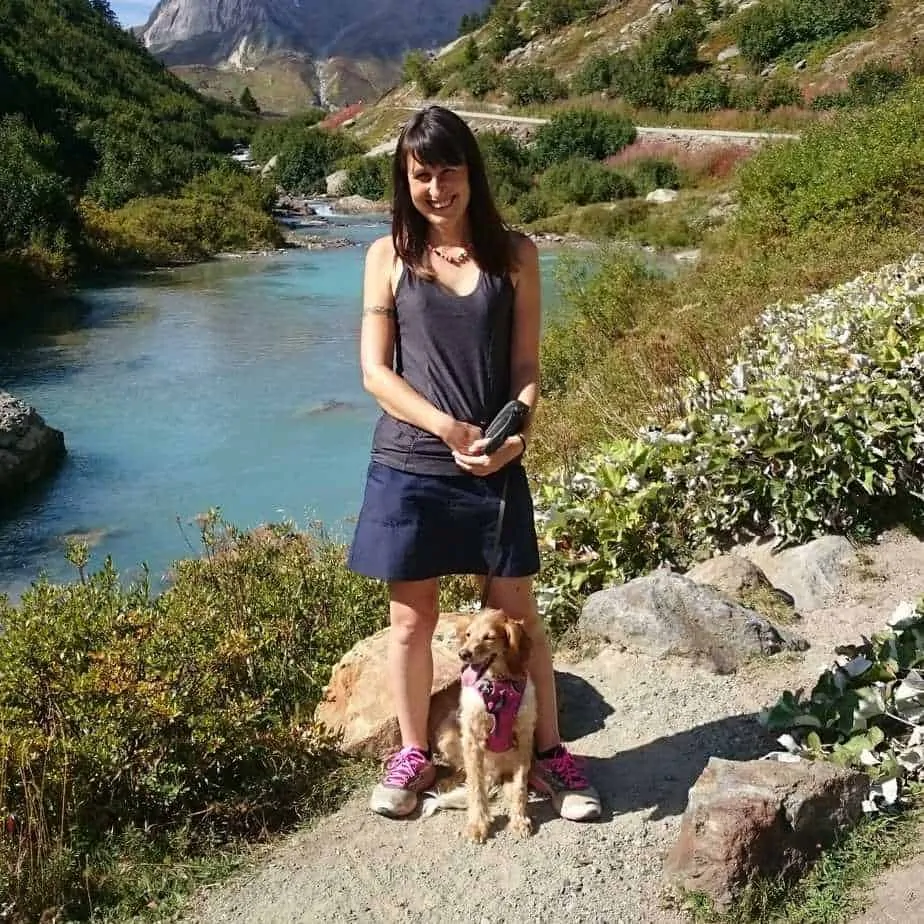
Gemma is an official dog nut and passionate traveller. Originally from the wonderful city of Edinburgh in Scotland, Gemma is now wandering across Europe with her rescue dog Annie. For ten years Gemma loved being surrounded by all things canine 24/7 whilst she ran a specialist doggy shop. The shop was a great community hub and, along with working closely with local rescues, Gemma provided customer support relating to canine behaviour and nutrition. It was a passion project and one that Gemma felt privileged to have created. She is also studying towards an Advanced Diploma in Canine Behaviour and is a huge advocate of dog rescue and promoting scientific methods of dog training.
